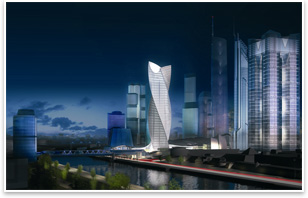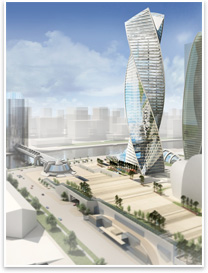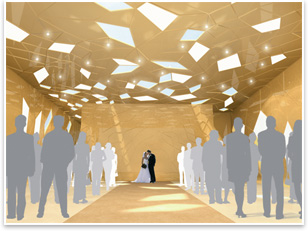
| Joining Man and Woman with Steel and Glass A unique collaboration births Moscow City Palace Tower
Summary: The partnership of RMJM-Edinburgh Group Design Director Tony Kettle and Edinburgh College of Art Professor Karen Forbes yielded the design for Moscow City Palace Tower, a mixed-use project that combines office space with a wedding chapel. Through its collaborative nature and formal themes, the tower illustrates the idea of joining a man and a woman in marriage. In an essay that begins RMJM’s book on their Moscow City Palace Tower project, the designers of the building write that they seek to reintegrate art and architecture after the ascent of International Style Modernism cleaved the two disciplines from each other in an attempt to banish ornamentation and recast architecture as a socially progressive, purely functional utility. The architects’ plan: to suture art and architecture back together from both directions, joining RMJM architects with an Edinburgh College of Art professor involved from early conceptual discussions to technical details. “This is a completely fused process all the way through,” says Forbes. This fusion extends beyond personnel as well. RMJM’s plan for the 46-story Moscow City Palace Tower grounded by two wedding chapels conflates authorship, design disciplines, and gender and marriage roles into a design that joins geometric complexity with material richness.
The building’s site is a former industrial area three miles from the Kremlin called Moscow City, which Kettle compares to the La Defense district outside of Paris, with its planned cluster of high rises and booming development. Moscow City Palace will contain office space, two wedding chapels, high-end retail space, and a museum and be connected to the Moscow subway system. Initial construction has begun, and the building is slated to be completed in four years. As the head of the School of Drawing and Painting at the Edinburgh College of Art, Forbes says she’s used to dealing with functional and managerial issues that are common to architecture, though perhaps not as common to a visionary auteur. “For any large artistic project, you’re going to have a number of people to discuss and debate with to get the thing realized,” she says. Kettle was also willing to take on sensibilities contrary to the popular image of his profession. By switching roles, the artist becomes the functional taskmaster and systems enthusiast, and the architect goes off in search of abstract inspiration. From the book: “We invert expectations, the artist is fascinated by the technical constraints which limit the core, the architects want a higher meaning won from this tower.” Fragmented embrace
History or visionary? Visitors (or future newlyweds) who visit Moscow City Palace are greeted by a grand reception area and progress up a processional staircase with a glass roof that looks skyward. At the glass-walled guest lobby, wedding parties assemble and prepare to enter one of the two chapels, which are large, open rooms with diamond shaped skylights punched through the roof. From there, parties can go downstairs to a champagne bar to celebrate or venture to the top-floor atrium of the tower, where open rooms provide flexible spaces for receptions with views of Red Square. Gold is a primary decorative material in the wedding chapel area, used in a “simple and abstract way,” says Kettle. Today, Russia is home to turbulently expanding capitalist horizons. RMJM (who merged with the Princeton, N.J.,-based architecture firm Hillier last summer) is building a $2.8 billion rapier-shaped tower in St. Petersburg, a city not known for cutting-edge contemporary architecture, for Gazprom, the Russian natural gas mega-corporation. AIA Gold Medal recipient Norman Foster is building what is reputed to be the biggest building in the world in Moscow: a $4 billion, 27 million-square-foot mixed-use development called Crystal Island. These show-stopping buildings transgress fading Soviet ideals of humble collectivism and class solidarity, and the gold-adorned wedding chapels of Moscow City Palace bring a similar idea of personal extravagance and living well into Russians’ intimate lives. Moscow City “Palace” even tosses in hints of czarist aristocracy. Are these traditions new or old for the nation? Perhaps both. Count that as another fusion for Moscow City Palace Tower. |
||
Copyright 2008 The American Institute of Architects. All rights reserved. Home Page |
||
news headlines
practice
business
design
recent related
› Building a Brand
› Architects Collaborate on Lisbon Research and Clinical Center
› An Everywhere Space for Everyone’s Religion
Visit RMJM-Hillier’s Web site.



